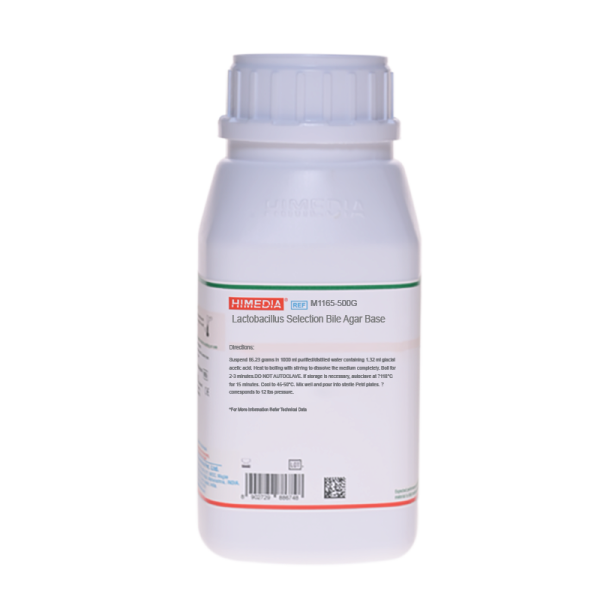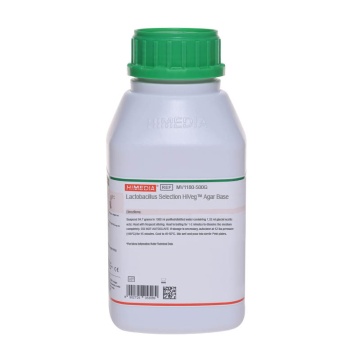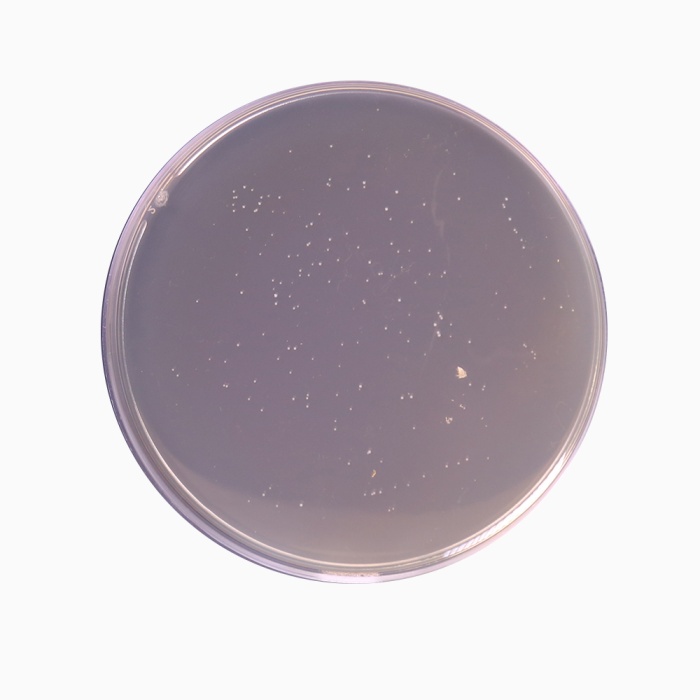 Your enquiry has been submitted
Your enquiry has been submitted
Lactobacillus Selection Bile Agar Base (LBS Bile Agar Base)
Lactobacilli#CC293D
Intended Use
Recommended for the selective isolation, cultivation and enumeration of Lactobacilli.
Composition**
| Ingredients | g/L |
|---|---|
| Tryptone | 10.000 |
| Yeast extract | 5.000 |
| Dextrose (Glucose) | 20.000 |
| Sodium acetate | 25.000 |
| Potassium dihydrogen phosphate | 6.000 |
| Ammonium citrate | 2.000 |
| Bile | 1.500 |
| Polysorbate 80 (Tween 80) | 1.000 |
| Magnesium sulphate | 0.575 |
| Manganese sulphate | 0.120 |
| Ferrous sulphate | 0.034 |
| Agar | 15.000 |
Final pH (at 25°C): 5.4±0.2
**Formula adjusted, standardized to suit performance parameters
Equivalent to Oxgall
Directions
Suspend 86.23 grams in 1000 ml purified/distilled water containing 1.32 ml glacial acetic acid. Heat to boiling with stirring to dissolve the medium completely. Boil for 2-3 minutes. DO NOT AUTOCLAVE. If storage is necessary, autoclave at A118°C for 15 minutes. Cool to 45-50°C. Mix well and pour into sterile Petri plates.
A corresponds to 12 lbs pressure.
Principle And Interpretation
Lactobacilli grow in a variety of habitats, wherever high levels of soluble carbohydrate, protein background products, vitamins and a low oxygen tension occur (1). These sites include the oral cavity, the intestinal tract (2,3), the vagina (4), food products (5) and dairy products (6). LBS Bile Agar Base, formulated by Gillil and and Speck (7) is recommended by APHA for the isolation and enumeration of lactobacilli. LBS Bile Agar Base is similar in composition to Lactobacillus Selection Agar Base, the only difference being the additional bile added to the former .
Tryptone and yeast extract serve as sources of essential nutrients. Dextrose is the carbohydrate and energy source. Polysorbate 80 serves as an additional source of growth factors and fatty acids required for metabolism of Lactobacillus species. Selectivity of the medium is obtained due to the presence of ammonium citrate and sodium acetate. These inhibit the accompanying microbial and fungal flora and also restrict swarming of colonies (8). The low acidic pH of the medium obtained by addition of glacial acetic acid is inhibitory to several bacterial species. Sulphates provide essential ions. LBS Bile Agar Base is made selective for bile-resistant lactobacilli by incorporating 0.15% bile.
Type of specimen
Food and dairy samples
Specimen Collection and Handling:
For food and dairy samples, follow appropriate techniques for sample collection and processing as per guidelines (5,6). After use, contaminated materials must be sterilized by autoclaving before discarding.
Warning and Precautions :
Read the label before opening the container. Wear protective gloves/protective clothing/eye protection/face protection. Follow good microbiological lab practices while handling specimens and culture. Standard precautions as per established guidelines should be followed while handling specimens. Safety guidelines may be referred in individual safety data sheets.
Limitations :
- Do not overheat; prolonged heating causes medium to darken and some types of lactobacilli present in the small numbers may not develop to full size, appear as pinpoint colonies.
- Further serological and biochemical testing is required for complete identification.
Performance and Evaluation
Performance of the medium is expected when used as per the direction on the label within the expiry period when stored at recommended temperature.
Quality Control
Appearance
Cream to yellow homogeneous free flowing powder
Gelling
Firm, comparable with 1.5% Agar gel
Colour and Clarity of prepared medium
Yellow coloured clear to slightly opalescent gel forms in Petri plates
Reaction
Reaction of 8.62% w/v aqueous solution at 25°C. pH: 5.4±0.2
pH
5.20-5.60
Cultural Response
Cultural characteristics observed in presence of 3-5% Carbon dioxide (CO2) after an incubation at 35-37°C for 48 hours.
| Organism | Inoculum (CFU) | Growth | Recovery |
|---|---|---|---|
| Lactobacillus acidophilus ATCC 4356 | 50-100 | luxuriant | >=50% |
| $Lactiplantibacillus plantarum ATCC 8014 | 50-100 | luxuriant | >=50% |
| Escherichia coli ATCC 25922 (00013*) | >=104 | inhibited | 0% |
| Staphylococcus aureus subsp. aureus ATCC 25923 (00034*) | >=104 | inhibited | 0% |
| Lactobacillus rhamnosus ATCC 9595 | 50-100 | luxuriant | >=50% |
| Enterococcus faecalis ATCC 29212 (00087*) | >=104 | inhibited | 0% |
| ## Proteus hauseri ATCC 13315 | >=104 | inhibited | 0% |
Key: * Corresponding WDCM numbers. ## Formerly known as Proteus vulgaris $ Formerly known as Lactobacillus plantarum
Storage and Shelf Life
Store dehydrated powder and the prepared medium at 2-8°C. Use before expiry date on the label. On opening, product should be properly stored dry, after tightly capping the bottle in order to prevent lump formation due to the hygroscopic nature of the product. Improper storage of the product may lead to lump formation. Store in dry ventilated area protected from extremes of temperature and sources of ignition Seal the container tightly after use. Product performance is best if used within stated expiry period.
Disposal
User must ensure safe disposal by autoclaving and/or incineration of used or unusable preparations of this product. Follow established laboratory procedures in disposing of infectious materials and material that comes into contact with sample must be decontaminated and disposed of in accordance with current laboratory techniques (9,10).
Reference
- Balows A., Truper H. G., Dworkin M., Harder W., Schleifer K. H., (Eds.), The Prokaryotes, 2nd Edi, 1992, Springer-Verlag
- Wiseman R. F, Sarles W. B, Benton D. A, Harper A. E and Elvehjem C.A., 1956, J. Bacteriol., 72:723.
- Ellis R. F. and Sarles W. B., 1958, J. Bacteriol., 75:272.
- Rogosa M. and Sharpe M. E., 1960, J. Gen. Microbiol., 23:197
- Salfinger Y., and Tortorello M.L. Fifth (Ed.), 2015, Compendium of Methods for the Microbiological Examination of Foods, 5th Ed., American Public Health Association, Washington, D.C.
- Wehr H. M. and Frank J. H., 2004, Standard Methods for the Microbiological Examination of Dairy Products, 17th Ed., APHA Inc., Washington, D.C.
- Gilliland S. E., Speck M. L., and Morgan C. G., 1975, Appl. Microbiol., 30:541.
- MacFaddin J. F., 1985, Media for Isolation-Cultivation-Identification-Maintenance of Medical Bacteria, Vol. 1, Williams and Wilkins, Baltimore.
- Isenberg, H.D. Clinical Microbiology Procedures Handbook 2nd Edition.
- Jorgensen, J.H., Pfaller, M.A., Carroll, K.C., Funke, G., Landry, M.L., Richter, S.S and Warnock., D.W. (2015) Manual of Clinical Microbiology, 11th Edition. Vol. 1.
| Product Name | Lactobacillus Selection Bile Agar Base (LBS Bile Agar Base) |
|---|---|
| SKU | M1165 |
| Product Type | Regular |
| Physical Form | Powder |
| Origin | Animal |
| Packaging type | HDPE |
| References | 1.Balows A., Truper H. G., Dworkin M., Harder W., Schleifer K. H., (Eds.), The Prokaryotes, 2nd Edi, 1992, Springer-Verlag2.Wiseman R. F, Sarles W. B, Benton D. A, Harper A. E and Elvehjem C.A., 1956, J. Bacteriol., 72:723.3.Ellis R. F. and Sarles W. B., 1958, J. Bacteriol., 75:272.4.Rogosa M. and Sharpe M. E., 1960, J. Gen. Microbiol., 23:1975.Downes F. P. and Ito K., (Eds.), 2001, Compendium of Methods for the Microbiological Examination of Foods, 4th Ed.,American Public Health Association, Washington, D.C.6.Wehr H. M. and Frank J. H., 2004, Standard Methods for the Microbiological Examination of Dairy Products, 17th Ed., APHA Inc., Washington, D.C.7.MacFaddin J. F., 1985, Media for Isolation-Cultivation-Identification-Maintenance of Medical Bacteria, Vol. 1, Williamsand Wilkins, Baltimore.8.Gilliland S. E., Speck M. L., and Morgan C. G., 1975, Appl. Microbiol., 30:541. |
| Customized Product Available | No |











